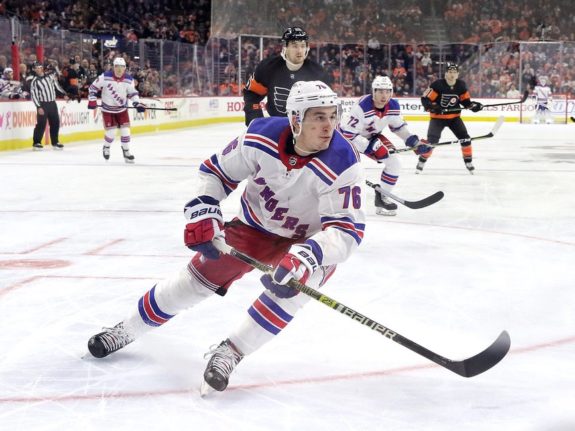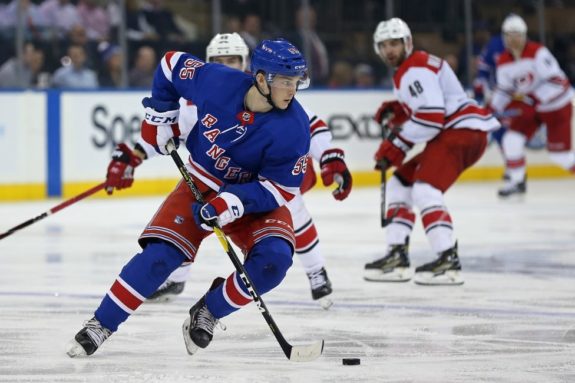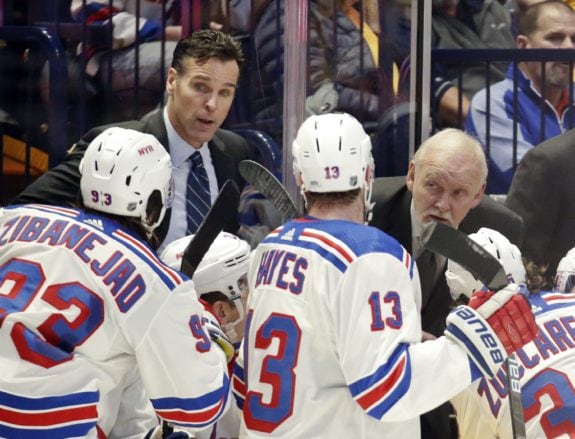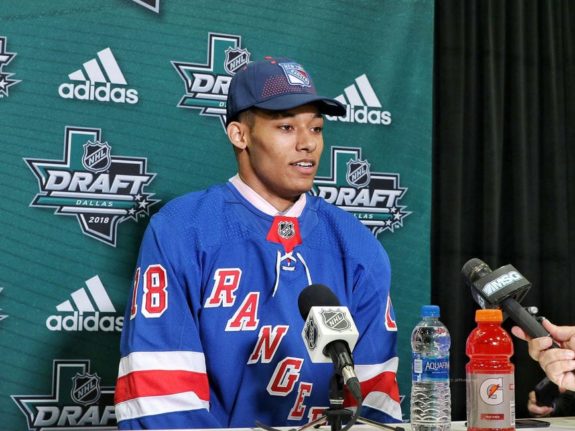The predictable roller-coaster effect of the New York Rangers’ rebuild has been in full effect over the past week-plus. The up-and-coming Blueshirts played three of their best games of the season mixed in with their absolute worst.
The extreme ups and downs have been figuratively vertigo-inducing for fans, no doubt. The kids, though, are playing, gaining invaluable experience and showing glimpses of what they can become. That was the whole point of this season and the overall process, right? Patience as the price for a better future?
The answer, of course, is yes. Yet a potentially major issue has emerged on defense, where poor contract decisions threaten to delay and even stunt the rebuild – a situation that needs to be resolved in short order, yet seems to present no easy solutions.
That would be on the left side of the blue line, where the onerous deals of Marc Staal and Brady Skjei have the potential to create a blockage for three talented youngsters whom the organization sees as potential key parts of the future.

The club continues to be hampered by former general manager Glen Sather’s decision to hand Staal, the steady, gritty and respected 32-year-old veteran, a six-year extension worth $34.2 million in Jan. 2015. The deal, which runs one more season after this one, carries a $5.7 million cap hit that for at least this season, appears to render him all but untradeable.
Staal has battled through concussion problems and a serious eye injury in 13 seasons since the Rangers drafted him 12th overall in 2005. He’s been a heart-and-soul warrior, an alternate captain since 2010. The hard truth, though, is that he was never worth that kind of contract. (from ‘Now Rangers Teammates, Eric and Marc Staal Recall Hit That Shook a Family, and a Career’, NY Daily News – 3/19/16)
Staal provides nothing offensively, and after a pair of resurgent seasons coming into 2019-20, it’s become apparent that his lack of mobility has left him vulnerable in the ever-faster NHL. Coach David Quinn finally bowed to the obvious Tuesday, making Staal a healthy scratch for the first time in his career, and again Saturday as the Rangers defeated the Nashville Predators 2-1 for their third win in four games.
“It was obviously not an easy one,” Quinn told Larry Brooks of the New York Post of his conversation with Staal. “I can sit here and tell you how much I respect the hell out of him, how much I like the guy, and it’s all legit and true, but it doesn’t make anybody feel any better.” (from ‘David Quinn had a hard time benching Rangers’ Marc Staal’, New York Post – 10/30/19)
Skjei Extension Looking Like a Mistake
As messy as the Staal situation is, the circumstances surrounding Skjei could prove worse. The Rangers’ flawed decision to extend him after his second season for six years at an annual cap hit of $5.25 million could ironically prove costly.

The club opted to write off as an aberration Skjei’s alarming 2017-18 campaign, in which he posted a minus-27 rating, and focus on his breakout 2016-17 effort in an attempt to lock in a cheaper contract long-term for a player it saw as a future cornerstone. At this point, choosing that course of action over a shorter bridge deal appears rash. Skjei wasn’t much better in 2018-19 and got off to another shaky start this season – the strong 2016-17 performance now looking like the aberration.
Paired with childhood friend Jacob Trouba as the assumed top-pair defensive unit, Skjei struggled out of the gate and was removed from the pairing after one game. He’s endured some extended stretches on the bench, though his game has picked up some recently.
Perhaps Quinn will help the 25-year-old rediscover his form of 2016-17. If he can’t, though – and Skjei should hardly be immune to joining Staal in street clothes, should that be warranted – the net effect is that this building club will effectively have two blocked spots on defense through next season. And as Ryan Lindgren has demonstrated in the last two games, that’s a major problem.
Recalled from Hartford to give the defense some edge and physicality, Lindgren teamed with Adam Fox as a formidable duo that helped the Rangers to a 4-1 victory over the powerful Tampa Bay Lightning on Tuesday, putting the memory of Sunday’s ugly 7-4 loss to the Boston Bruins in the past and showing why the Blueshirts are so high on Lindgren. The rookie was stout again Saturday in helping to hold down the high-scoring Predators. (from ‘Marc Staal Opens Up About Being Benched by Rangers’, New York Post – 11/2/19)
The 21-year-old, acquired as a key element in the Rick Nash trade with the Bruins in February 2018, needs the chance to play every night after getting into five games last season. With fellow highly regarded youngster Libor Hajek ensconced as Trouba’s partner in what’s been a mostly successful pairing, Lindgren getting regular duty means Staal or Skjei will have to consistently sit. The issue, though, doesn’t come close to ending there.

Waiting in the wings, if not ready just yet, is 2018 first-round draft pick K’Andre Miller, the big and fast University of Wisconsin defenseman who’s off to a strong start with the Badgers this season and whose expected arrival on Broadway is drawing closer. The same goes for Yegor Rykov, another left-side, defensive prospect who’s currently injured but signed a two-year entry-level deal in the offseason.
Rykov, coached in the KHL by former Rangers defenseman Sergei Zubov, was acquired from the New Jersey Devils in the Michael Grabner trade in February 2018 and is also seen as a promising option for the Blueshirts’ future. How, though, will all of this work? Can Lindgren, Miller and Rykov break-in on the left side with two big contracts occupying spaces there?
While Staal’s deal runs out after next season, that’s a relative eternity given Lindgren’s possible readiness now. Staal’s contract essentially has two years left. Is Quinn prepared to keep scratching him for the rest of 2019-20 if Lindgren grabs the job and runs with it?

“We bring up Lindgren and there are a lot of things that go into these decisions, but it was just something I felt that was needed and the best thing for our team right now,” Quinn told the New York Post. “We want to run a meritocracy here and guys that play well will continue to play.
“But I have a lot of faith (Staal) is going to play up to his capabilities and be in the lineup consistently.” (from ‘The Rangers’ Changing of the Guard has Arrived’, New York Post – 10/30/19)
Staal, a proud player, predictably hasn’t taken sitting well.
“Obviously I was upset and pretty frustrated,” he told the New York Post. “There weren’t a lot of talks (about what I needed to improve) and that’s why I was a little upset and frustrated by it. I was caught off guard that way.
“I think, internally, what it always comes down to is obviously (there is) a reason why they decided to take me out. So, just don’t give them that reason.” (from ‘Marc Staal Opens Up About Being Benched by Rangers’, New York Post – 11/2/19)

How about a buyout? Well… yikes. Per Cap Friendly, doing so with Staal’s contract after this season would incur a cap charge of $3,566,667 for 2020-21, as well as a $1,066,667 hit for 2021-22. That would leave the Rangers with more than $11 million in dead space for next season thanks to the already bought-out deals of Kevin Shattenkirk, Dan Girardi and Ryan Spooner.
A Skjei buyout is too scary to contemplate, and the Rangers aren’t prepared to do it anyway. Still, what happens if Hajek continues on an upward trajectory, Lindgren proves to be the physical presence so desperately needed on the Rangers blue line and Miller’s progress forces the issue in the next two seasons? What about Rykov? There already appears to be no room.
Finding Space for Lindgren, Miller Won’t be Easy
Shifting one of the left-handed defensemen to the right side would hardly be an ideal solution, and that doesn’t look like an option anyway. The right looks much more settled going forward, with Trouba signed long-term, impressive rookie Adam Fox on the rise and 24-year-old Tony DeAngelo looking at an extension provided he turns in another strong season generating offense from the blue line.
Whatever course of action the Rangers settle on, general manager Jeff Gorton will need to be more careful with the next round of contracts he hands out. Hajek and Lindgren weren’t acquired to be traded; the same goes for the drafting of Miller, a physical specimen for whom the club gave up a second-round pick on draft day to move up four spots to select. Where Rykov would fit is anyone’s guess.
The decision to extend Staal four years ago will reverberate through the organization for at least two more seasons; the Skjei extension is acquiring the look of a potential longer-term albatross.
These logjams often seem to work themselves out. Skjei could continue to find his game and fulfill his first-round pedigree. Lindgren could prove unready. Staal’s amazing career survivability could thrust him back into a key role. The converted forward, Miller, could bomb playing defense on the NHL level. Rykov could prove to be just a prospect.

That’s a lot of “coulds.” The problem is, the Rangers’ rebuilding mandate means they need to get a look at all of their young players who earn a shot, and Staal and Skjei don’t appear to be going anywhere – at least this season.
The types of bad contracts that have hamstrung the defense – the ones given to Staal, Shattenkirk, Brendan Smith and, to be determined, Skjei – were avoided upfront, and that’s allowed for youth to be served at those spots. Kaapo Kakko, Pavel Buchnevich, Filip Chytil, Brett Howden and others fill out the forward lines nightly, unencumbered by immovable veterans whose deals would all but require them to play.
There’s no such luck on the blue line, with Gorton set to endure a $6,083,333 million cap hit from the bought-out Shattenkirk alone in 2020-21. Will the GM swallow hard and take on even more dead space by doing the same with Staal? What other options exist?
For the rest of this season, handling the problem falls to Quinn, who knew he’d face these types of situations when he took the Rangers job. By next summer, though, it will likely be on the front office to alleviate the issue and navigate its ongoing rebuild around the short-sighted decisions that threaten a key aspect of its goal of organization development.